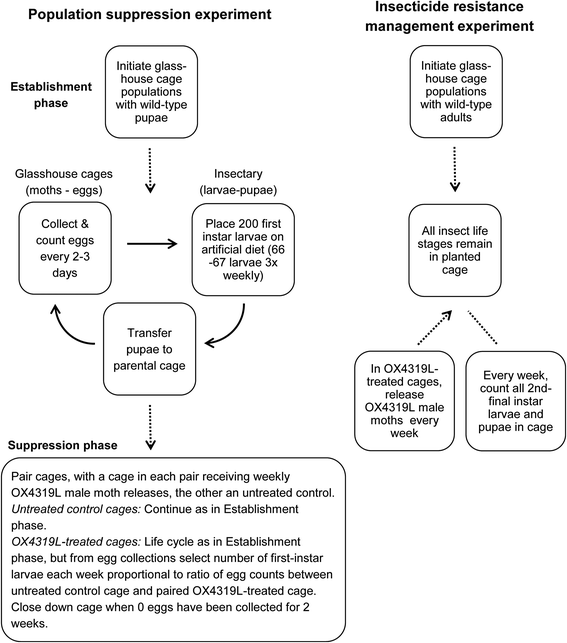Pest control and resistance management through release of insects carrying a male-selecting transgene
- PMID: 26179401
- PMCID: PMC4504119
- DOI: 10.1186/s12915-015-0161-1
Pest control and resistance management through release of insects carrying a male-selecting transgene
Abstract
Background: Development and evaluation of new insect pest management tools is critical for overcoming over-reliance upon, and growing resistance to, synthetic, biological and plant-expressed insecticides. For transgenic crops expressing insecticidal proteins from the bacterium Bacillus thuringiensis ('Bt crops') emergence of resistance is slowed by maintaining a proportion of the crop as non-Bt varieties, which produce pest insects unselected for resistance. While this strategy has been largely successful, multiple cases of Bt resistance have now been reported. One new approach to pest management is the use of genetically engineered insects to suppress populations of their own species. Models suggest that released insects carrying male-selecting (MS) transgenes would be effective agents of direct, species-specific pest management by preventing survival of female progeny, and simultaneously provide an alternative insecticide resistance management strategy by introgression of susceptibility alleles into target populations. We developed a MS strain of the diamondback moth, Plutella xylostella, a serious global pest of crucifers. MS-strain larvae are reared as normal with dietary tetracycline, but, when reared without tetracycline or on host plants, only males will survive to adulthood. We used this strain in glasshouse-cages to study the effect of MS male P. xylostella releases on target pest population size and spread of Bt resistance in these populations.
Results: Introductions of MS-engineered P. xylostella males into wild-type populations led to rapid pest population decline, and then elimination. In separate experiments on broccoli plants, relatively low-level releases of MS males in combination with broccoli expressing Cry1Ac (Bt broccoli) suppressed population growth and delayed the spread of Bt resistance. Higher rates of MS male releases in the absence of Bt broccoli were also able to suppress P. xylostella populations, whereas either low-level MS male releases or Bt broccoli alone did not.
Conclusions: These results support theoretical modeling, indicating that MS-engineered insects can provide a powerful pest population suppressing effect, and could effectively augment current Bt resistance management strategies. We conclude that, subject to field confirmation, MS insects offer an effective and versatile control option against P. xylostella and potentially other pests, and may reduce reliance on and protect insecticide-based approaches, including Bt crops.
Figures



Similar articles
-
Effect of Bt broccoli and resistant genotype of Plutella xylostella (Lepidoptera: Plutellidae) on development and host acceptance of the parasitoid Diadegma insulare (Hymenoptera: Ichneumonidae).Transgenic Res. 2011 Aug;20(4):887-97. doi: 10.1007/s11248-010-9471-9. Epub 2010 Dec 23. Transgenic Res. 2011. PMID: 21181494
-
Effects of Bt plants on the development and survival of the parasitoid Cotesia plutellae (Hymenoptera: Braconidae) in susceptible and Bt-resistant larvae of the diamondback moth, Plutella xylostella (Lepidoptera: Plutellidae).J Insect Physiol. 2004 May;50(5):435-43. doi: 10.1016/j.jinsphys.2004.03.001. J Insect Physiol. 2004. PMID: 15121457
-
Modeling the integration of parasitoid, insecticide, and transgenic insecticidal crop for the long-term control of an insect pest.J Econ Entomol. 2013 Jun;106(3):1103-11. doi: 10.1603/ec12287. J Econ Entomol. 2013. PMID: 23865173
-
Insect pathogens as biological control agents: Back to the future.J Invertebr Pathol. 2015 Nov;132:1-41. doi: 10.1016/j.jip.2015.07.009. Epub 2015 Jul 27. J Invertebr Pathol. 2015. PMID: 26225455 Review.
-
Bt transgenic crops do not have favorable effects on resistant insects.J Insect Sci. 2004;4:4. doi: 10.1093/jis/4.1.4. Epub 2004 Feb 12. J Insect Sci. 2004. PMID: 15861220 Free PMC article. Review.
Cited by
-
Silencing RNAs expressed from W-linked PxyMasc "retrocopies" target that gene during female sex determination in Plutella xylostella.Proc Natl Acad Sci U S A. 2022 Nov 16;119(46):e2206025119. doi: 10.1073/pnas.2206025119. Epub 2022 Nov 7. Proc Natl Acad Sci U S A. 2022. PMID: 36343250 Free PMC article.
-
A transgenic female killing system for the genetic control of Drosophila suzukii.Sci Rep. 2021 Jun 21;11(1):12938. doi: 10.1038/s41598-021-91938-1. Sci Rep. 2021. PMID: 34155227 Free PMC article.
-
Evaluation of Additional Drosophila suzukii Male-Only Strains Generated Through Remobilization of an FL19 Transgene.Front Bioeng Biotechnol. 2022 Mar 15;10:829620. doi: 10.3389/fbioe.2022.829620. eCollection 2022. Front Bioeng Biotechnol. 2022. PMID: 35372301 Free PMC article.
-
Corn Stunt Disease: An Ideal Insect-Microbial-Plant Pathosystem for Comprehensive Studies of Vector-Borne Plant Diseases of Corn.Plants (Basel). 2020 Jun 14;9(6):747. doi: 10.3390/plants9060747. Plants (Basel). 2020. PMID: 32545891 Free PMC article. Review.
-
Insect pest control, approximate dynamic programming, and the management of the evolution of resistance.Ecol Appl. 2019 Mar;29(2):e01851. doi: 10.1002/eap.1851. Epub 2019 Feb 12. Ecol Appl. 2019. PMID: 30656770 Free PMC article.
References
-
- Kenis M, Auger-Rozenberg M-A, Roques A, Timms L, Péré C, Cock M, et al. Ecological effects of invasive alien insects. J Biol Inv. 2009;11:21–45. doi: 10.1007/s10530-008-9318-y. - DOI
-
- Oerke E-C. Crop losses to pests. J Agric Sci. 2006;144:31–43. doi: 10.1017/S0021859605005708. - DOI
-
- Knipling E. Possibilities of insect control or eradication through the use of sexually sterile males. J Econ Entomol. 1955;48:459–69. doi: 10.1093/jee/48.4.459. - DOI
-
- Dyck VA, Hendrichs J, Robinson AS, editors. Sterile insect technique: principles and practice in area-wide integrated pest management. The Netherlands: Springer; 2005.
Publication types
MeSH terms
Grants and funding
LinkOut - more resources
Full Text Sources
Other Literature Sources

